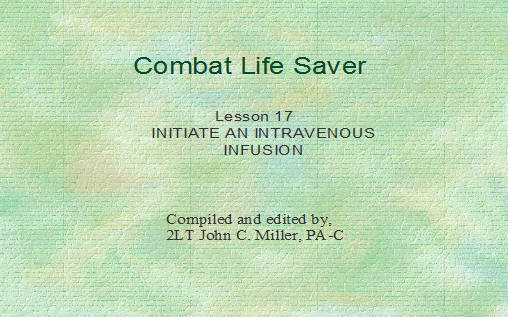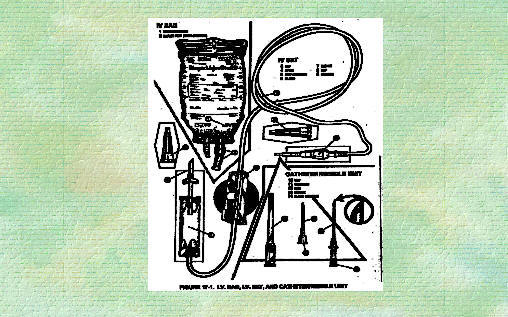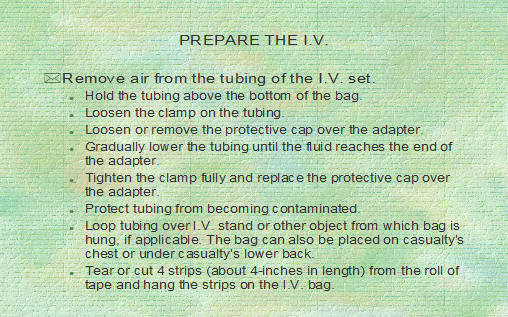INITIATE AN INTRAVENOUS INFUSION
Click here to download the presentation.



Lesson 17
INITIATE AN INTRAVENOUS
INFUSION
INTRODUCTION
Hypovolemic shock is a condition caused by a sudden decrease in the volume of fluid in the body’s blood circulatory system. This condition can be fatal. The combat lifesaver must be prepared to initiate an intravenous infusion (I.V.) to add fluid to the casualty’s circulatory system. The sooner the casualty receives I.V. fluids, the more rapid the improvements in his condition.
INITIATE AN INTRAVENOUS
INFUSION
TASK
Initiate an intravenous infusion (I.V.).
CONDITIONS
Given needed supplies and a simulated casualty.
STANDARD
Score a GO on the performance checklist.
IDENTIFY SIGNS AND SYMPTOMS OF
HYPOVOLEMIC SHOCK
Causes of Hypovolemic Shock
Hypovolemic shock is caused by a loss of fluid or blood from the casualty’s circulatory system. It is usually caused by rapid or severe bleeding or by serious (second and third degree) burns over at least 20 percent of the body. Excessive fluid loss can also result from vomiting, diarrhea, or heat injuries such as profuse sweating and dehydration.
IDENTIFY SIGNS AND SYMPTOMS OF
HYPOVOLEMIC SHOCK
Signs and Symptoms of Hypovolemic Shock
Severe bleeding from wounds or large burned areas on skin.
Anxiety.
Changes in level of consciousness, such as going from alert to semiconscious or unconscious. If possible, record the casualty’s AVPU: Alert, Verbally responsive, Painful response, Unresponsive.
IDENTIFY SIGNS AND SYMPTOMS OF
HYPOVOLEMIC SHOCK
Mental confusion.
Ask casualty questions that cannot be answered by a simple yes or no, such as, “What is your name? What is the month? What day of the week is it? Where are we?”
Restlessness and agitation.
Irregular or fluctuating pulse in early stages, weak and rapid pulse in later stages.
Cool, clammy skin.
Change in skin color (from normal to pale, bluish, or grayish tint).
IDENTIFY SIGNS AND SYMPTOMS OF
HYPOVOLEMIC SHOCK
Dilated pupils, nonreactive to light.
Rapid, shallow breathing.
Thirst, dry mouth.
Nausea or vomiting.
Pulse rate over 100.
PERFORM PRELIMINARY MEASURES TO
TREAT A CASUALTY FOR
HYPOVOLEMIC SHOCK
Check the casualty for breathing. Take measures to restore breathing (mouth-to-mouth resuscitation, etc.) if needed. If the casualty is unconscious, monitor the casualty’s breathing and perform mouth-to-mouth resuscitation if the casualty stops breathing.
Control major bleeding (field dressing, pressure dressing, and/or tourniquet as needed).
Dress and seal open chest wounds.
Dress open abdominal wounds and open head wounds.
PERFORM PRELIMINARY MEASURES TO
TREAT A CASUALTY FOR
HYPOVOLEMIC SHOCK
Position the casualty on his back and place a log or folded jacket under his feet with his feet above the level of his heart.
PERFORM PRELIMINARY MEASURES TO
TREAT A CASUALTY FOR
HYPOVOLEMIC SHOCK
Question:
When would you not elevate the casualty’s feet?
Response:
When the casualty has a suspected fracture of the thigh, leg, or ankle (unless the fracture has already been splinted).
When he has an open abdominal wound (casualty should be placed in flexed-knee position instead).
When he has an open chest wound (position casualty on injured side).
When he has an open head wound (have casualty sit up or lie on side with wound away from ground).
PERFORM PRELIMINARY MEASURES TO
TREAT A CASUALTY FOR
HYPOVOLEMIC SHOCK
Loosen the casualty’s clothing (tight clothing may interfere with circulation).
Clothing is not loosened in a chemical environment.
Start an intravenous infusion.
Keep the casualty from getting too warm or too cool.
Monitor his breathing and pulse.
PUT ON GLOVES
Question:
Why would you put on gloves before starting an I.V.?
Response:
It will reduce the chance of infection resulting from the I.V. puncture.
Question:
What would you do if you were in the field and could not put on gloves before starting the I.V.?
Response:
Start the I.V. anyway.
GATHER AND CHECK I.V. SUPPLIES
Identify I.V. Supplies.
2 bags of I.V. fluid.
2 intravenous injection sets.
2 catheter and needle units.
Constricting band.
Antimicrobial pads.
Scissors.
Adhesive tape.
Adhesive bandages.
Antimicrobial ointment (if used).
GATHER AND CHECK I.V. SUPPLIES
Check the I.V. Set, Catheter/Needle, and I.V. Bag
Check the I.V. set box and the catheter/needle protective packaging for tears and water marks.
Discard if no longer sterile.
Tear the protective bag and remove the actual I.V. bag.
Check the bag for clarity of fluid and leaks.
Discard if the expiration date has passed, if the inner bag has a leak, or if the fluid is discolored or has sedimentation.
Remove the I.V. set from the box. Discard the set if the tubing is cracked or discolored.
PREPARE THE I.V.
Identify the outlet port and expiration date on the I.V. bag; the spike, drip chamber, clamp, tubing, and adapter on the I.V. set; and the flash chamber, hub, catheter, and needle on the catheter/needle unit.
Remove the I.V. set from its protective bag.
Loosen the clamp (if needed); slip the clamp along the tubing until there is 6 to 8 inches of tubing between the clamp and the drip chamber; then tighten the clamp.
PREPARE THE I.V.
Remove protective covering from the I.V. fluid bag’s outlet port without touching the end of the port.
Remove protective cap from spike on infusion set with a twisting motion. Do not touch the end of the spike.
Insert spike into the exposed I.V. outlet port with a twisting motion so the spike breaks the seal in the outlet port. Do not touch the end of the port or spike.
Hang bag on a stand or other object or hold bag up.
Squeeze the drip chamber until the drip chamber is half full of fluid.
PREPARE THE I.V.
Question:
What could happen if you do not remove the air from the tubing?
Response:
Air could be forced into the casualty’s circulatory system. The air bubble (air embolism) could cause the casualty’s heart to stop beating (cardiac arrest).
PREPARE THE I.V.
Remove air from the tubing of the I.V. set.
Hold the tubing above the bottom of the bag.
Loosen the clamp on the tubing.
Loosen or remove the protective cap over the adapter.
Gradually lower the tubing until the fluid reaches the end of the adapter.
Tighten the clamp fully and replace the protective cap over the adapter.
Protect tubing from becoming contaminated.
Loop tubing over I.V. stand or other object from which bag is hung, if applicable. The bag can also be placed on casualty’s chest or under casualty’s lower back.
Tear or cut 4 strips (about 4-inches in length) from the roll of tape and hang the strips on the I.V. bag.
SELECT AND PREPARE AN INFUSION SITE
Position the casualty with his palm upward.
Select two possible sites.
Question:
I have found two possible injections sites where the vein is straight, springy and does not roll. Which site should I use for my first attempt?
Response:
The more distal site (closest to the hand, farthest from the heart).
SELECT AND PREPARE AN INFUSION SITE
Place the constricting band around the casualty’s arm 6 to 8 inches above the selected (distal) infusion site.
Stretch the band slightly.
Wrap the band around the arm so one end is longer than the other.
Secure the band by looping the longer end and drawing the shorter end over the loop and under the tubing. This allows the band to be released using only one hand. Be sure the tails point away from the infusion site.
SELECT AND PREPARE AN INFUSION SITE
Tell the casualty, if conscious, to clench and relax his fist several times and then to keep his fist clenched. If unconscious, place the limb below the level of the heart.
Palpate (feel) the vein with your fingertips again.
Open a packet containing a povidone-iodine impregnated cotton pad and remove the pad.
Cleanse the skin at the site with the pad beginning at the site and spiraling outwards.
INITIATE INFUSION
Open the protective packaging of the catheter/needle unit.
Remove the unit from its protective packaging.
Grasp the stem (connected to the needle) with your dominant hand and the protective cap from the catheter/needle with your nondominant hand.
Remove the cap from the catheter/needle unit and discard the protective cap.
Hold the catheter/needle with the bevel of the needle up.
INITIATE INFUSION
Place the thumb of your nondominant hand about 1 inch below the injection site and over the vein.
Press on the skin to make the skin over the injection site taut.
Position the needle slightly to the side of the vein at approximately a 20 degree to 30 degree angle to the surface of the skin with the bevel up.
Insert the bevel into the skin.
Lower the angle of the needle until it is almost parallel to the skin surface.
INITIATE INFUSION
Insert the needle into the vein (a slight “give” may be felt) and hold the needle steady.
Look at the flash chamber and check for blood in the flash chamber.
Question:
On the battlefield, what should you do if you try to start an I.V. on a casualty two times and both tries are unsuccessful?
Response:
Evacuate the casualty.
INITIATE INFUSION
Once blood is seen in the flash chamber, advance the catheter/needle unit about 1/8 of an inch farther to ensure that the catheter itself is in the vein.
Continue to hold the flash chamber with your dominant hand. Grasp the catheter hub with your other hand and thread the rest of the catheter (not the needle) into the vein (to the hub). Never reinsert the needle back into the catheter.
While holding the catheter hub with the nondominant hand, use a finger on that hand to press lightly on the skin over the catheter tip.
INITIATE INFUSION
Remove the flash chamber and needle from the catheter with your dominant hand and lay the flash chamber and needle to one side.
Tell the casualty to unclench his fist.
Remove the constricting tubing. The constricting band should have been in place for less than two minutes.
Grasp the adapter end of the I.V. tubing with your dominant hand.
Remove the protective cap from the adapter.
Quickly insert the tip of the adapter tightly into the hub of the catheter.
INITIATE INFUSION
Lift your finger from over the tip of the catheter.
Loosen the clamp on the tubing.
Check the drip chamber to make sure fluid is flowing.
Adjust the clamp so the fluid is flowing fast, but the fluid is seen as individual drops rather than as a steady stream of water.
Question:
Suppose the casualty has a head injury. What would you do differently?
Response:
Adjust the clamp so the fluid is flowing at about 10 drops per minute.
INITIATE INFUSION
Check the infusion site for infiltration (fluid leaking into surrounding tissue instead of entering the vein).
The infusion site is swollen, red, and cool to the touch.
The casualty has greater pain than expected.
Clear fluid is leaking from the site.
Question:
What would you do if the infusion site was infiltrated?
Response:
Discontinue the I.V. and start another I.V. using a new needle at a site above the old (infiltrated) site.
SECURE THE I.V
Remove one tape strip from the bag and place diagonally across the catheter hub. Continue to keep the adapter and hub in place.
Remove a second strip and place across the hub forming an “X”.
Remove the third strip of tape and place it across the adapter. The adapter and catheter are now secure.
Make a safety loop with the tubing. Secure the loop with the last piece of tape. The loop helps to prevent the catheter from being dislodged if the tubing is accidentally pulled.
SECURE THE I.V.
Position the I.V. bag so fluid will flow from the bag, through the drip chamber and tubing, and into the casualty’s vein.
If possible, hold the bag up or hang it from a limb or other object that is higher than the casualty’s heart. Gravity will cause the fluid to flow.
If the bag cannot be hung or held, place the bag under casualty’s lower back. The pressure from the body will force fluid out of the bag.
SECURE THE I.V.
Question:
What else can you do to control shock?
Response:
Cover the casualty with a blanket or poncho if the weather is cool; shade casualty and remove excess clothing if it is hot. Continue to monitor the casualty’s respirations and pulse.
REMOVE THE CATHETER
Tighten the clamp on the tubing to stop the flow of fluid.
Loosen and remove the tape from the loop of I.V. tubing. Start at the ends of tape and loosen toward the middle.
Loosen and remove the strip of tape securing the adapter.
Loosen and remove the two strips of tape securing the catheter hub.
REMOVE THE CATHETER
Remove the catheter from the vein by pulling it out at an angle almost parallel to the skin (the same angle used in inserting the needle).
If desired, povidone-iodine antimicrobial ointment can be applied to the puncture site to help to protect the puncture wound from infection.
Cover the puncture site with an adhesive bandage. Explain that covering the site with an adhesive bandage will help to stop bleeding and prevent the puncture wound from becoming contaminated.
INITIATE AN INTRAVENOUS
INFUSION
CLOSING
Remember, the basic treatment procedures for treating a casualty are: make sure the casualty is breathing adequately, control serious bleeding, and control shock.
If a casualty has lost a good deal of blood, the most important procedure other than promptly controlling the bleeding is to initiate an I.V. to control hypovolemic shock.
INITIATE AN INTRAVENOUS
INFUSION
CLOSING (cont)
The quicker the casualty receives intravenous fluids, the better his chances for surviving. An I.V. can be maintained while the casualty is being evacuated. If a medic arrives before the casualty is evacuated, he can maintain the I.V. and administer additional fluids using the same catheter and tubing. Initiating an I.V. is probably the most challenging task in your Combat Lifesaver training.
Questions